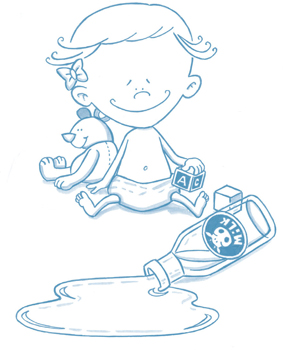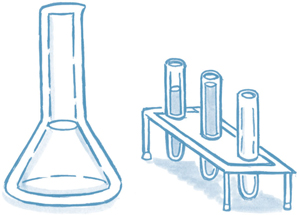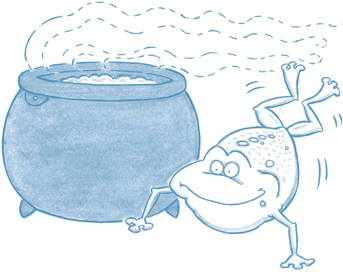Everything Kids' Magical Science Experiments Book (10 page)
Read Everything Kids' Magical Science Experiments Book Online
Authors: Tim Robinson
Tags: #epub, ebook

Take another diaper and with an adult's help, cut it open so you can see the materials inside. Pour these materials into an empty cup, preferably a clear one. Now slowly pour water into the cup and watch how the particles absorb water and grow. Keep pouring water into the cup until all the dry particles are wet. Can you turn the cup upside down without any water falling out? Depending on how much water you poured and how much of the absorbent diaper material you used, you may find that nothing comes out at all. Then, try adding some table salt and mixing with a spoon. You should see the water come back, as the salt reacts with the gel you produced to release the water.

The first disposable diaper can be traced back to the year 1950. Today, nearly 20 billion disposable diapers are used each year in the United States.

Visit the HowStuffWorks. com Web site to learn more about the magic behind disposable diapers:
http://science.howstuffworks.com/ question207.htm.

Have you ever tried to mix several colors together to make new colors, only to find that you ended up with a dark brown or black mixture? This typically happens when you mix multiple colors together. But sometimes, if you mix the right colors in the right order, you can produce a surprising result that will amaze you.
Question: Can you mix colors to end up with your original color?
If you were to mix several paint colors together, you would undoubtedly produce a black or very dark brown color. But in this experiment, it's the order in which you mix the colors, combined with the types of liquid you are mixing, that makes the experiment work. Instead of using colored water, you will use grape juice, ammonia, and vinegar. The reactions, completed in the correct order, will produce color changes that end up giving you the same color of liquid that you begin with.

SAFETY NOTE:
Do not drink any of the liquids in this experiment. They may look safe, but can be very dangerous.

INDICATOR:
A liquid that changes color in the presence of an acid or a base.
BASE:
Chemical opposite of an acid. Bases tend to be bitter tasting as opposed to sour-tasting acids. Bases in large concentrations can be very dangerous.
The key to this experiment is the use of grape juice. Grape juice is an indicator that can tell you whether an acid or base is present. Depending on what kind of liquid you mix it with, it will change colors. When an indicator mixes with a base, it tends to turn green, and when it mixes with an acid, it tends to turn red. The key is trying to understand which of the other liquids is an acid and which is a base.
- 3 small drinking glasses
- Unsweetened grape juice
- Water Liquid ammonia
- Vinegar
- Measuring spoons
- Eyedropper
- Mix one tablespoon of unsweetened grape juice with about four ounces of water in one of the three glasses. It should have a pale reddish color.
- Place 5â7 drops of ammonia in the second glass.
- Place 10â15 drops of vinegar in the third glass.
- Carefully pour the grape juice from the first glass into the second and gently swirl until it is completely mixed. Make a note of the color of the new liquid mixture.
- Finally, pour the liquid from the second glass into the third and swirl until it is completely mixed. Make a note of the color of the new liquid.

- Describe the colors of your liquids in each stage of the experiment.


- Based on the description given at the beginning of the experiment, do you think that ammonia is an acid or a base?


- Based on the descriptions given at the beginning of the experiment, do you think that vinegar is an acid or a base?


- What do you think would have happened if you had mixed the liquids in a different order? Try it and see what happens.


